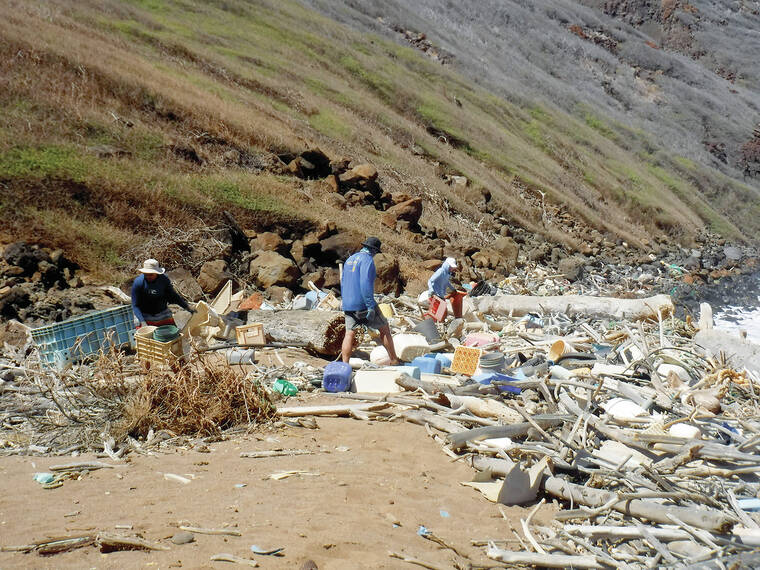KANAPOU BEACH, Maui — A cleanup on a remote beach east of the island of Maui netted an estimated 5 tons of marine debris in an effort hampered by the COVID-19 pandemic, as well as logistical issues.
The Kaho‘olawe Island Reserve Commission and volunteers wrapped up a multi-year project to pick up a wide variety of trash, most of which was plastic, from Kanapou Beach, on the island of Kaho‘olawe, which is part of the County of Maui, but sits about seven miles east of Maui.
The cleanup culminated on Wednesday, Jan. 18, when 23 fabric bags crossed the channel between Kaho‘olawe and Maui via a Windward Aviation helicopter before arriving at the commission’s base yard. Once all the bags were transported across the channel, they were placed in two large roll-off containers.
However, some of the plastics were left on the uninhabited island in order to be used as erosion control structures, said Margaret Pulver, public information specialist for the commission, in a statement. She said the material flown to Maui will be taken by a local nonprofit organization to create second-life products.
Pulver, who referred to Kanapou Beach as a “North Pacific Garbage Patch,” said the site is a place where plastics and discarded fishing line now accumulate instead of the driftwood that populated the beach decades ago.
“Clearly some of the debris is generated locally, but much of it is carried by ocean currents across thousands of miles,” she said. “When it aggregates at Kanapou, the trash is ankle deep, so we try to conduct these cleanups every three years or so to avoid having to stand-up multiple operations.”
The final step of airlifting the marine debris was delayed for several years because of the COVID-19 pandemic and logistical issues. While the effort to rid Kanapou Beach of marine debris was a success, the site won’t stay debris-free for long, said Lopaka White, maintenance and vessel operator for the commission, in a statement. He also said it’s disheartening to see how fast and how much trash can find its way to the island.
“You collect 2 tons, and then another 2 tons shows up,” said White, a 17-year employee. “It’s everything, including bowling balls, snorkel equipment, fishing gear — you name it, we see it.”
Access to the island is restricted because of the presence of unexploded ordnance that stems from its previous use as a bombing range in the aftermath of the attack on Pearl Harbor in 1941.
When the U.S. Navy ended its clearance project in 2004, roughly 75 percent of the island had been cleared of unexploded ordnance. Of that area, about 10 percent, or 2,647 acres, were additionally cleared up to a depth of 4 feet, according to the commission. That left approximately 25 percent, or 6,692 acres, that were not cleared of unexploded ordnance.
•••
Wyatt Haupt Jr., editor, can be reached at 808-245-0457 or whaupt@thegardenisland.com.


